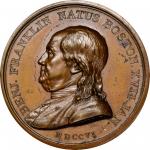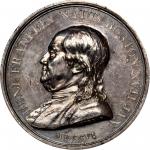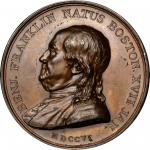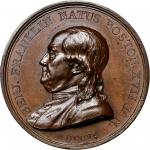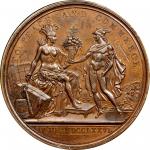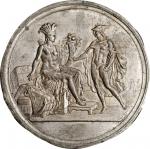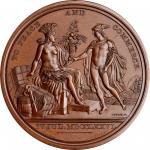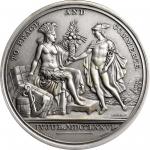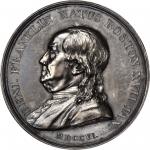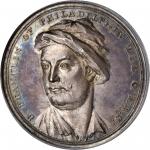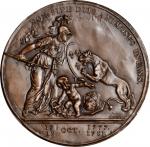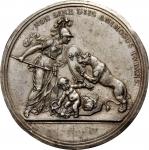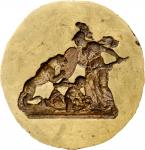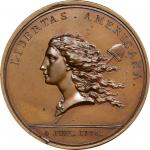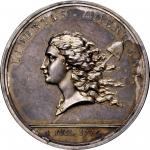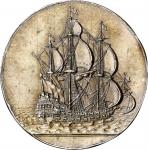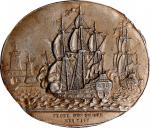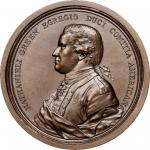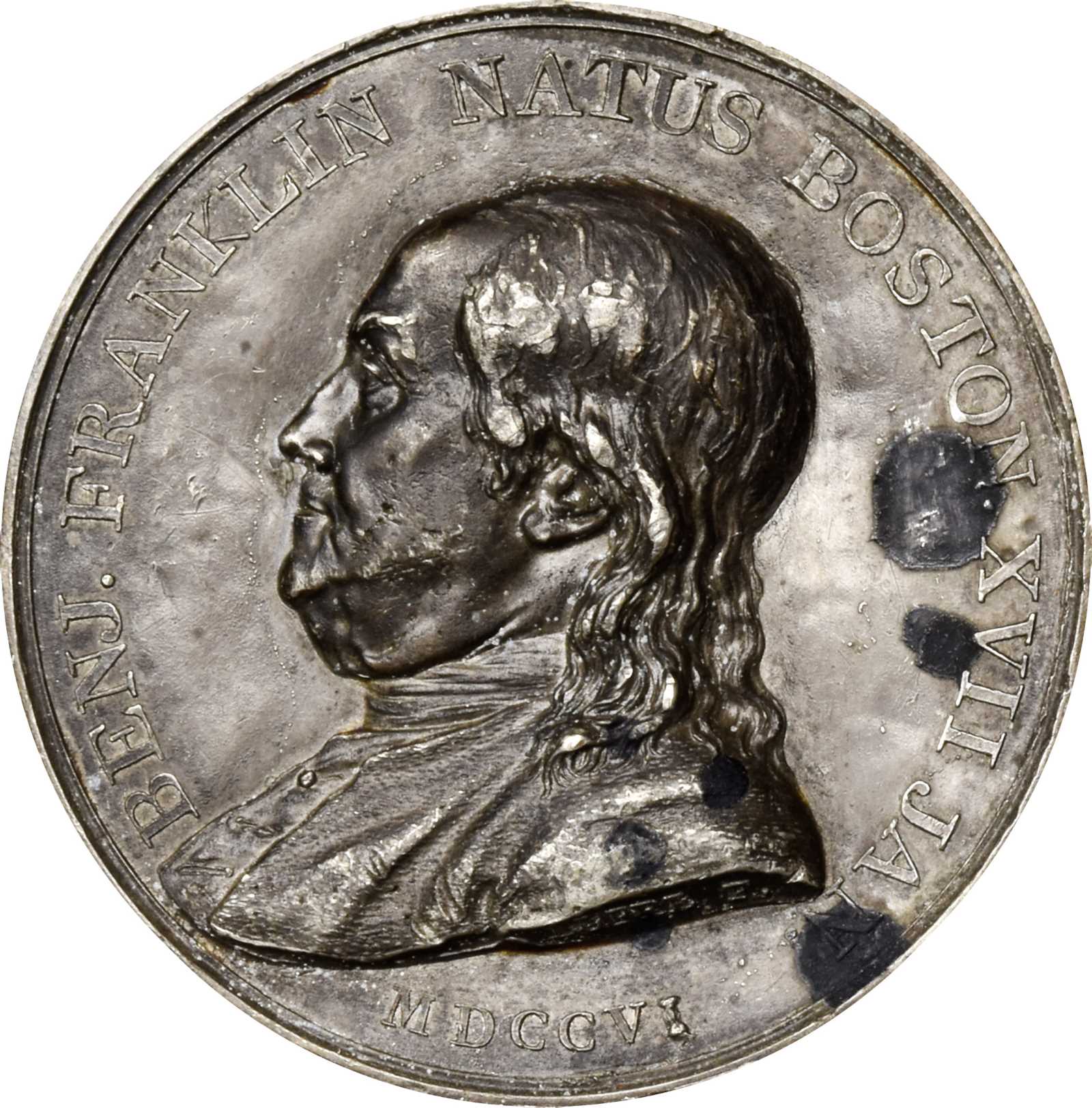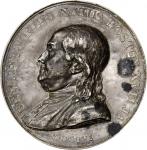1784 Benj. Franklin Natus Boston obverse cliche. As Betts-619. White metal. Original dies. Workshop of Augustin Dupre. 44.0 mm. 179.4 grains. 1.2 - 1.9 mm thick. About Uncirculated.Plain trimmed edge. Backed with traces of orange or amber wax, as if once stuck to a letter. An exciting trial piece, from a very early state of this obverse die, but after the correction of the error date (as seen on the unique silver piece, above). This cliche must have been struck after the silver example with the distinctive incuse date correction, but before the rest of the mintage of both Betts-619 and Betts-620. The surfaces are glossy dark gray, a little wavy but with a smooth texture, attractive and original in appearance. A few circular areas of trivial surface corrosion are noted, behind Franklins head, beneath the rear corner of the bust truncation, and on the relief of the truncated shoulder, but these are inactive and largely blend in.<p>The only other obverse cliche from this die weve ever seen or heard of was included in LaRiviere III, May 2001, lot 1117. None were in Ford, and none are held by the American Numismatic Society, Boston Public Library, or Massachusetts Historical Society (though MHS does have a reverse cliche). None are mentioned or illustrated in the Musee Carnavalet Dupre catalog (which does reference drawings related to this issue that are held in the Bibliotheque Nationale and American Philosophical Society).<p>Though Betts-620 is comparatively common, this unprepossessing cliche from the obverse it shares with Betts-619 is of the highest rarity and importance.<p><strong>A Note On Trials: Cliches, Epreuves, and Splashers </strong><p><p>The Adams Collection of Comitia Americana and related medals is uniquely enriched by several specimens of a unique form of medallic production that is known by several different names. Typically struck from a die in its earliest state, usually before hardening, these trials were called epreuves - proofs - in the original French correspondence between Dupre and Duvivier and the Founding Fathers charged with the acquisition of the medals the Continental Congress authorized. In more modern numismatic literature, they are more often called cliches or splashers, the latter term being a fair description of just how these trials were made.<p>Unhardened dies are incredibly susceptible to damage, as 18th century die steel (and modern steel today) is brittle before it is hardened by quenching. Once a die is hardened, modification becomes very difficult, so if changes need to be made, they need to be done in that fragile, unhardened state. Engravers in major mints - Paris especially - were accustomed to making soft metal impressions as something of a proofreading copy, enabling the negative die to be viewed in the positive in rough draft form. Wax impressions were liable to leave bits of wax in the interstices of design elements, thus engravers settled upon tin (usually called "white metal" in modern numismatic circles) as the best medium.<p><p>Tin melts at 450 degrees Fahrenheit, a low enough melting point to be accomplished in any small workshop. A ladle full of molten tin poured onto a surface will cool and harden fairly quickly, but remain soft long enough that a die can be easily pushed into it by hand, leaving a relatively durable impression in medal. Most often, medalists would find a piece of scrap paper - a note, a newspaper, a book page - to pour the tin atop, thus preventing their workspace from getting scorched and making the tin sheet somewhat easier to lift and trim. <p><p>These splashers were not intended to be medals, or even permanent, but simply a temporary way to display the state of the die in the positive before its devices were rendered immovable. Each was personally crafted by the engraver in his shop. In the case of the Comitia Americana medals, the epreuves made by Duvivier, Dupre, and Gatteaux were ultimately intended to be viewed and handled by themselves and those close to the process. Benjamin Franklin reviewed the epreuves of the De Fleury medal between April 20 and May 4, 1780, then made recommendations regarding the lettering in the obverse exergue that were adopted by Duvivier. He later did the same with his Libertas Americana medal, correcting a spelling error on the reverse. Engraver Augustin Dupre retained many of his splashers in his personal collection, some of which found their way into institutions in France and the United States, some of which are in the present sale.<p><p>Thomas Jefferson used cliches as a spendthrift (and lightweight) way to collect all the medals of the Comitia Americana series, assembling a set for himself and another for his Virginia countryman James Madison. As he was preparing to depart Paris in September 1789, he wrote to Madison to let him know of the boxes he was shipping, including a box of books and several crates full of Houdons John Paul Jones busts that the sitter wanted to have distributed in America. <p><p><em>I have put a collection of the proofs in tin of the medals voted by the U. S. (except two, of which the dies are in America) the medals themselves not being allowed to be taken, I desired the workmen to let me have two sets of their last proofs; for their manner is, as their work proceeds, to make impressions of it in pure tin, in order to correct &c. These proofs are in fact more delicate than the medals themselves, and the last of them shew the impressions complete. I have had them arranged in a frame, under glass &c. & beg your acceptance of them.</em><p><p>By "delicate," Jefferson did not mean fragile, but well-detailed. The modern whereabouts of these sets are unknown; it is very possible that some proportion of either of these sets are in the current sale.<p><p>Jeffersons set left Monticello in February 1798 in the hands of an enslaved man named York, who Jeffersons son-in-law and overseer, the abusive drunkard Thomas Mann Randolph, called "allmost (sic) an idiot." Randolph told Jefferson that the thief had confessed, listing off an inventory of items from Jeffersons chambers including "some impressions in lead & tin of Dies of the Medals & Coins." He continued "I have some hope of recovering the proofs of Medals (tis from the description I conclude they are out) I have traced one to a Negroe of the neighbourhood who bt. it of York but he says he has lost it." The historical record on the theft and recovery thereafter falls silent; Jefferson wrote several consecutive letters to Randolph after the receipt of this letter but never acknowledged the incident. Two different men named York were enslaved by Jefferson concurrently, one of whom was inherited from the estate of Jeffersons father-in-law in 1774 and described as a "Waterman," the other of whom was born in 1781 and labored at Monticello. Presumably the York involved here was the latter of these two, aged 17 at the time of his act of resistance against Jeffersons authority.<p><p>Today, cliches of each of the Comitia Americana medals are extremely rare, with populations in the low single digits. There is not a single issue in this format that is known to the extent of 8 or 10 pieces. Matched sets of obverse and reverse are the exception rather than the rule. Each of the survivors is an accident, a piece that was made to serve a purpose at a moment in time, not produced for long-term preservation in a cabinet. Their historicity is exceptional, as each survivor was not only in the hands of the medals engraver, but likely in the hands of Thomas Jefferson, Benjamin Franklin, David Humphreys, or a small number of others. Their rarity surpasses that of their normally struck cognates in nearly every circumstance.<p><p>With the possible exception of the Charles Senter Collection, sold at auction in 1933, no cabinet has ever included such a wide array of these historic rarities as the John Adams Collection.<p><p><p><strong>Benjamin Franklin Natus Boston</strong><p>The exact circumstances that led up to Augustin Dupre creating a medal to honor Benjamin Franklin are unclear. There is little paper trail emanating from either of these gentleman, artist or subject, to indicate that a special anniversary or incident was being celebrated. Rather, this seems to be what has long been termed a "personal medal," that is, a medal to honor a figure whose character was admired by the artist who created it.<p>Sketches in the collections of the American Philosophical Society and Boston Public Library, as well as three retained in the Dupre estate, show the evolution of Dupres design concept for the reverse of this medal. Several drawings depict a fully grown Hercules - a play on the infant Hercules who represents America on the Libertas Americana medal - trampling two figures, one of whom wears a crown and holds a broken scepter. Eventually Dupre came upon versions of the Winged Genius design that were close to the adopted motif. The legend ERIPUIT COELO FULMEN SCEPTRUMQUE TYRANNIS, commonly translated as "He snatched lightning from the heavens and the scepter from tyrants," is typically attributed to Turgot, the French politician and economist. It first appeared on a print of Franklin dated 1778, and various versions of the phrase floated around France thereafter. The legend is found on one of Ninis large size Franklin portraits in terracotta, dated 1779, and its often found hand-inscribed on the back of the smaller and more commonplace 1777 Nini Franklin portraits as well.<p>Franklin said little about this medal, which may suggest that he heard little about it - the Betts-619 from original dies is rare enough today to suggest that very few of them were struck during Franklins lifetime. Indeed, by the time Franklin left his French home at Passy for good on July 12, 1785, Dupres celebratory medal was probably still a fairly well kept secret. His friend E.A. Gibelin, who helped design the reverse of the Libertas Americana medal, wrote him on February 7, 1785, on various topics and noted "M. Dupre le graveur men a montre une avec linscription eripuit coelo fulmen etc." or "Mr. Dupre the engraver showed me one with the inscription eripuit coelo fulmen etc." No other mention of this medal appears in Franklins papers, save a handbill advertising the Comte dEstaings 1790 work entitled "Appercu Hazarde Sur LExportation Dans Les Colonies," which was dedicated to Franklin and illustrated the Winged Genius medal on its title page.<p>As beautiful as Dupres first effort was, it was short lived and has proved a major rarity today. The reason the second medal, Betts-620, supplanted the first is clear from studying the medals: the initial reverse failed and was, unfortunately, replaced with a far less imaginative one. This second type was all that was available when Jefferson built the small collection to present to President George Washington, now conserved at the Massachusetts Historical Society. Sometime after Franklins death, the first reverse design was brought back again with a new copy die; as popular as Franklin was in life, he became perhaps more so in death. The original obverse die and the original replacement die (with wreath) also lived on for generations of restrikes. After 1842, these restrikes were marked on the edge with Paris Mint privy marks. They remain accessible enough to suggest that they were popular sellers throughout the 19th century in France and abroad.<p><strong>The Benj. Franklin Natus Boston Medal:</strong><p><strong>Obverse:</strong> Franklins profile faces left, based on the portrait bust by Houdon, with DUPRE F. on the shoulder truncation. The date MDCCVI beneath the bust represents the year of his birth, 1706. The legend BENJ. FRANKLIN NATUS BOSTON XVII JAN around the periphery completes the thought: "Benjamin Franklin born at Boston, January 17."<p><strong>First Reverse:</strong> A winged genius, symbolizing brilliance of thought, stands at center with one hand raised to the thunderbolt behind him. A lightning rod, invented by Franklin, attracts the bolt atop a temple at left. A broken scepter and crown lay on the ground at right. The peripheral legend ERIPUIT COELO FULMEN SCEPTRUMQUE TYRANNIS, or "He snatched lightning from the heavens and the scepter from tyrants," is perhaps the most famous aphorism about Franklin. In the exergue, Dupre takes full credit: SCULPSIT ET DICAVIT / AUG. DUPRE ANNO / MDCCLXXXIV or "Engraved and dedicated by Augustin Dupre in the year 1784."<p><strong>Second Reverse:</strong> A simple oak wreath contains the legend ERIPUIT COELO FULMEN SCEPTRUMQUE TYRANNIS. Below the wreath, the legend continues in three lines: SCULPSIT ET DICAVIT / AUG. DUPRE ANNO / MDCCLXXXVI<p><p><p><p><p><p><p>From the John W. Adams Collection. Acquired from John Kraljevich Americana, January 2016.


